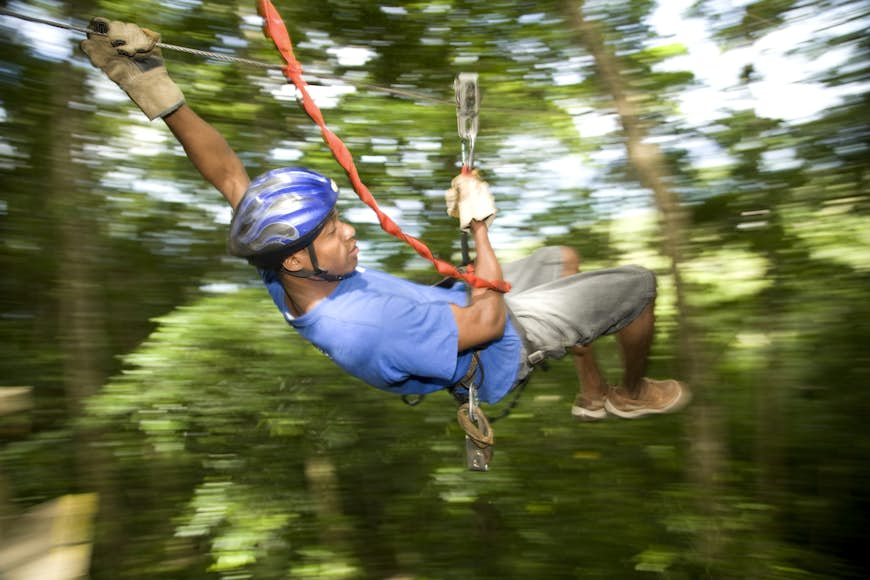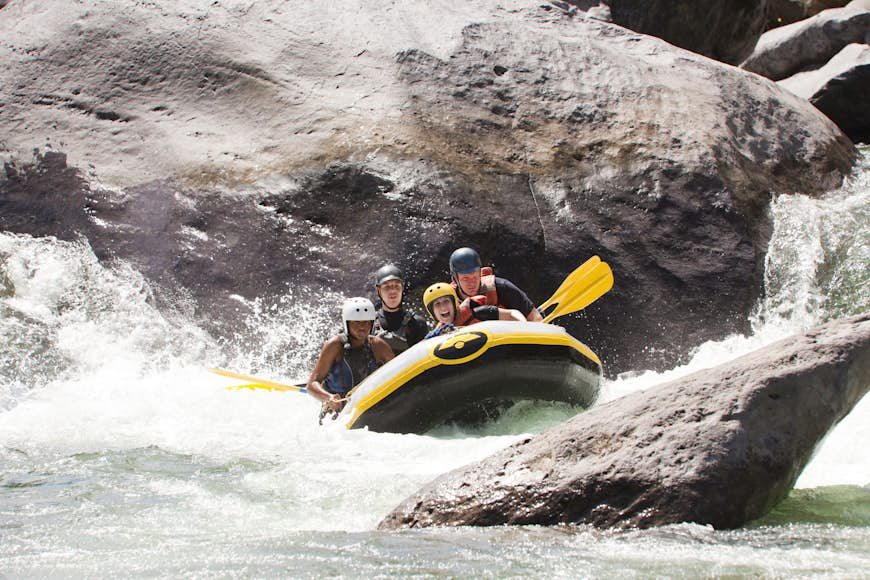A warm, subtropical climate makes Honduras an ideal year-round destination. The best time to visit depends on what you want to do. Many outdoor activities are weather-dependent and to make travel planning extra fun, some parts of Honduras remain dry while the rest of the country gets lashed by tropical deluges.
Whenever you visit, be prepared both for sun and rain, and pack a sweater for the cooler highlands. Here’s our guide to the best time to visit Honduras.
January to June is the best time to visit for outdoor adventure
Sunny, warm days and brisk nights draw visitors to Honduras to explore the Mayan ruins of Copán, hike in the mountains around Lago de Yojoa, and soak up the atmosphere in the quirky coastal town of Trujillo.
It’s also the driest time to hit the Bay Islands, where you can head beneath the waves to explore the world’s second-largest barrier reef while the visibility is best (January to March).
Summer rains fall on the Honduras mainland in May and June, though the Bay Islands remain relatively dry as they have their own microclimate. Alternatively, you can laze about on white-sand beaches in Roatán and on tiny Cayos Cochinos. This is Honduras’ busiest season, so hotel prices spike around New Year and during Easter.
July to September is best for whale shark spotting
While solo whale sharks are spotted around the island of Utila from February to April, the June to September migration season gives you the best chance of spotting small schools of these gentle giants of the deep.
October to December is best for white-water sports and exploring Moskitia
While mainland Honduras is battered by torrential downpours during the rainy months, and overland travel is affected by occasional flooding and mudslides, conditions for white-water rafting and kayaking are particularly good after the rainiest months of September and October.
August to November is also an excellent time to jump aboard a river boat and explore the remote La Moskitia region, which has its own mini dry season. Scuba diving centers on Roatán and Utila stay open year-round, and while visibility isn’t as great as during the drier months, now is the time to get some real bargains on diving packages.
Does Honduras have a hurricane season?
Honduras’ east coast and the Bay Islands are bathed by the Caribbean Sea, and the region is notoriously affected by the Atlantic hurricane season that typically lasts from June to late November.
However, the last time the Bay Islands were affected was in 1998 when Hurricane Mitch scored a direct hit. Odds are, you’ll only encounter a tropical storm or two in September or October. If you’d rather not take your chances, opt to travel during the high season instead.

January is for post-festival relaxation
A relatively quiet month, everyone goes back to work after the Christmas celebrations and the Three Kings parades on January 6. It’s cold at night in Santa Rosa de Copán, Tegucigalpa, and other high-altitude destinations, but it’s a great time to head out to the Bay Islands where balmy temperatures and the last of the winter rains are a boon for beach bums and scuba divers alike.
Key Events: Día de Los Reyes Magos, El Guancasco
February is great for scuba diving
The driest month of the year means terrific visibility for scuba divers visiting Roatán and Utila; if you’re lucky, you may spot the first solitary whale shark of the year. It’s a wonderful time to explore the Mayan ruins at Santa Rosa de Copán, but pack a sweater or two for the cold nights. Carnival (Shrove Tuesday, a week before the start of Lent) is celebrated with gusto across the country.
Key Events: Feria de la Virgen de Suyapa, El Baile de los Diablitos de Comayagua
March is for hiking in the highlands
The days are warming up in the highlands but the nights remain breezy and cool; take advantage of the ideal spring weather to hit the mountain trails around Lago de Yojoa. Diving and beach season are in full swing on the Bay Islands.
Key Events: Festival de San José, Semana Santa, Fiesta de San Gabriel

April is for Easter festivities
Easter is one of the biggest festivals in Honduras. Highlights include solemn processions and carpets of flowers. While the highlands are beginning to see rain showers, they rarely last long, and warmer evenings bring an influx of visitors to Santa Rosa de Copán.
Key Events: Semana Santa, Día de los Américas, Festival Punta Gorda
May is for Honduran Mardi Gras
The start of the rainy season in mainland Honduras; daytime temperatures remain hot and muggy. Coastal La Ceiba kicks off its two-week-long carnival – the biggest party in Central America, complete with costumed parades, exuberant dancing in the streets, and live music.
Key Events: Feria San Isidro, Gran Carnaval Internacional de La Ceiba
June is the beginning of hurricane season
It’s still relatively dry in the Bay Islands. Elsewhere in Honduras, it’s one of the hottest and rainiest months of the year. In the forests, savannahs, and grasslands to the far east of the country, humidity is close to 100%. Hurricanes begin to form in the Atlantic.
Key Event: Feria Juniana
July is for whale shark watching
If you have your heart set on spotting whale sharks, now is the time to visit the Bay Islands, since it’s the peak of the annual whale shark migration, and you have a good chance of diving with a pod of these remarkable creatures.
Key Event: Festival Garifuna

August is when Honduras goes on vacation
Coastal Honduras is ruffled by occasional tropical storms, and the rough seas can make traveling to the Bay Islands by boat a bit of a rollercoaster. Pods of whale sharks are still spotted in the depths around Utila, and it’s warm and pretty dry in the northern highlands – a pleasant time to be in Santa Rosa de Copán. Many Hondurans go on vacation in August, so book your accommodations in advance.
Key Events: Feria Agostina, Festival del Maiz
September is for river travel in the Moskitia region
While the mainland is drenched by the heaviest rains of the year, a mini dry season in remote Moskitia in eastern Honduras is the perfect time for intrepid explorers to head for the Rio Platano Biosphere Reserve and the small indigenous villages in the jungle, accessed only by river boat. September 15sees Independence Day celebrations all over the country.
Key Event: El Día de Independencia
Honduras road trip to the Copán Ruins
October is for heavy downpours
There are few tourists in the Bay Islands as heavy rains mean poor visibility for divers. Tropical storms continue to batter the north coast, whilst inland, downpours can cause delays on the roads. Moskitia remains relatively dry.
Key Event: Fiesta del Pescado
November is for white-water rafting
The rainy season is coming to an end and with the rivers swelled up by fall rains, it’s time to go white-water rafting on Río Cangrejal. The Chortí, an indigenous people in the Santa Rosa de Copán area, spend much of the month celebrating their biggest annual festival, Tzikin.
Key Event: La Ceremonia de Tzikin
December is festival season
Festivities are in full swing during the weeks preceding Navidad (Christmas), so head for Santa Barbara to catch the Royal Walk of the Giant Chimneys, or the north coast to witness Garifuna drumming and processions. It’s the start of the dry season, and accommodations get booked up ahead of the holidays.
Key Events: El Paseo Real de las Chimenea Gigantes, Festival Garífuna, Navidad
